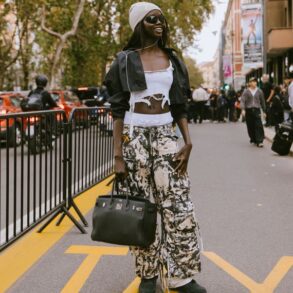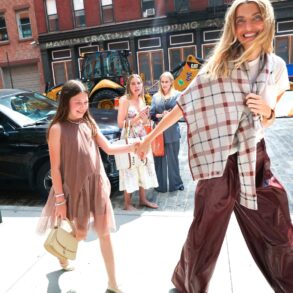The name Chris Robinson is synonymous with filmmaking excellence. For over 30 years, he’s been one of the most highly-regarded videographers of Hip Hop by directing videos with his signature use of cinematic brilliance and storytelling.
Robinson’s canon of classic videos includes “03 Bonnie and Clyde” by JAY-Z and Beyoncé, “Make It Clap” by Busta Rhymes, “P.I.M.P” Remix by 50 Cent featuring Snoop Dogg and G-Unit, “You Don’t Know My Name” by Alicia Keys, and “Make It Rain” by Fat Joe featuring Lil Wayne just to name a few.
In the world of television, Robinson was behind the camera on BET Honors (2009–16), “The New Edition Story, Wu-Tang: An American Saga,” and several episodes of “Black-ish,” “Grown-ish,” “Mixed-ish,” and many others.
As a feature filmmaker, Robinson directed the critically acclaimed “ATL,” “Beats,” and “Shooting Stars,” which was released in 2023.
For our “Director’s Cut” series, BET.com spoke with Robinson about some of his favorite videos he’s directed, transitioning into TV and film, and a legendary rapper that he once tried to battle.
BET.com: When did you first discover you wanted to be a film director?
Chris Robinson: It was in the 80s. You know, I played high school football. I thought I was going to the NFL or that I would be a rapper [Laughs]. I played college ball in Northern California and then I realized that there were other human beings named Somaons who were bigger and faster than everybody. We’ve never seen them in Baltimore you know, we were playing football. During one semester, there was a film class that I took and one of the older guys who was in the film program gave me a book called She’s Gotta Have It by Spike Lee. Then I went to Blockbuster and became notorious at Blockbuster because I never returned the movie. I must have watched She’s Gotta Have It like 57 times after reading the book from cover to cover in one sitting. All of a sudden, everything changed. Football, which meant everything to me, took a backseat to film and the rest is history.
BET.com: How did growing up in Baltimore shape your perspective as a film filmmaker?
Chris Robinson: It’s funny how you go through things in your life, and you don’t realize it but I believe that the path was always there. Recently, my dad gave me some report cards from the second grade with comments saying that I was being disruptive in class because I was always telling stories that the kids loved. I think there was just an affinity for it. I used to watch Westerns where my grandfather and those were just some of the best times because we couldn’t afford cable at our house. At some point, my aunt got cable and I went over there and saw this thing called MTV. Then there was this other crazy thing called BET and I was hooked.
BET.com: I once heard that you tried to battle LL Cool J as a teenager. How did that turn out?
Chris Brown: [Laughs} I entered a contest on a syndicated show called Pump It Up hosted by Dee Barnes. I was mesmerized by that show. For the contest, you had to do a remake of LL’s “Boomin System,” which was a great promotion by Def Jam. Me and my brother played LL and came up with the concept for the video. So we got to New York on Amtrak and they treated us like kings. We went to dinner with LL, his mom, and his grandmother. So I told my boy that I was going to battle LL. After everything wrapped up, I stepped to him about battling and he just kind of laughed. He told me, “ Listen, man, I’m not going to battle you. I saw the video and what you do is great. You need to meet everybody here and get their number. They might be interns today but these people will be your contacts that will grow as you grow.” He was so right. All of those interns became heads of the music video department and the president of the label like Kevin Lilies who’s also from Baltimore. Margo Wainwright became the head of video at Def Jam. All those people I still know and so much of my career were predicated on them knowing me from that moment.
BET.com: Although your official debut was in 1991 with “Doo Doo Brown” by 2 Hyped Brothers & A Dog, a club classic and personal favorite of mine, you came to prominence in 1997 when rap videos started to get big budgets. The Beatnuts “Off the Books” featuring Big Pun was his first appearance in a video. How was it to work on that project?
Chris Robinson: I just had a concept of the video being in all Black and all white. We shot it on Wall Street. That’s Wall Street. We’re in Red Hook when they’re in black. That was before Red Hook was what it is today. It was abandoned with old sugar factories and the buildings looked bombed out. So we did quite a bit there but there was tension on the set because everyone didn’t want to trust my ideas. I had my crew with us from Baltimore and they had their crew from the Bronx but Pun kind of defused the situation.
He tells me, “Chris, I know you’re totally against anything dope but I have an idea.” Everybody started cracking up and everything was cool from there. Once I finished the video, they loved it. I worked on so many of Pun’s, Fat Joe’s, and Terror Squad’s videos. They are extremely loyal.
BET.com: One of the hallmarks of your videos is that you have so many cameos from other rappers and celebrities. In “Bad Boy For Life,” how did it all come together?
Chris Robinson: Those were the years when we would go plan a video and then halfway through the video, Diddy would go, “I gotta shoot another one tomorrow with a different group. Can you do it?” And I’d be like, “ Okay.” It was just a beautiful time. We shot that on the backlot on Wisteria Lane, made famous by the Desperate Housewives show and it was great. Getting all those cameos was the power of Diddy. A lot of people were already in L.A. like Pat O’Brien, Ben Stiller, Mike Tyson, Ice Cube, and Shaq who all came through. That time was a combination of Diddy’s superstardom and the culture, the energy that was happening at the time. He had Sean John going and it was a beautiful time to be a part of it and to have the freedom to create within it was a dream for a director.
BET.com: Nas’s “One Mic” is one of the most acclaimed visuals in your videography. How did you develop that concept?
Chris Robinson: I was at a small museum in Soweto, South Africa and there was a picture of all these children that left school one day and were marching during Apartheid. The policeman shot into the crowd and murdered a bunch of children from 8-15. Another photo showed a child carrying another child who was shot. That image stuck with me. It was in my heart and head. Everywhere people of color are, we catch hell. So I started conceiving ideas for “One Mic” and thought about the bravery of those kids protesting in South Africa and what was going on with young girls in America. I thought, “They’re never going to do this because the labels were really about entertaining the audience, not telling a message.”
When I sent it, Nas immediately got it. I wanted to go to Africa to shoot it because I was so inspired but the label wasn’t going for it. We wound up shooting the whole video in L.A. We had some great scouts back then and they were going up to different places with different looks. We had a great art director named Rob Buono, a genius who did so much stuff with me. John Perez shot it on a 35-millimeter. I thought that song was special and the idea was special. We were honoring the people and honoring these children in South Africa.
BET.com: Another all-time favorite video is “Pass the Courvoisier, Part II.” How much fun did you have creating that one?
Chris Robinson: When discussing creatives in Hip Hop, Busta Rhymes is one of the best. Many artists don’t like being on a set for 12 to 15 hours because they’re used to going into the studio on their own time. But filmmaking takes a lot of the time and Busta Rhymes likes being there and dealing with the details just as much as the music. Busta could easily be a director. So we laid that one out by spending a lot of time having conversations and it just kept getting bigger and bigger. We added an extra day and got Jaime Foxx in it. I’m definitely proud of that one because that video is now being studied in marketing courses in college. Because of the song, sales for Courvoisier went up 15%, which equaled millions of dollars. I thought that Busta should have been given a stake in the company but instead, they gave him a free case [Laughs]. But that moment led to people getting their own liquor deals like Diddy did with Ciroc. Brands began to understand that Hip Hop artists could be ambassadors of their products. So that’s one of my favorite memories as a director.
BET.com: “Roc Boys” by JAY-Z is another star-studded video. What was your vision behind that one?
Chris Robinson: Getting Jay, Nas, and Diddy in the same room was incredible but that video was tough to shoot. We’re in New York City at the 40/40 club which was new at the time in the middle of winter. It was snowing and raining. Every person wanted to shoot for five minutes and leave. It was a stressful day for me. But none of that matters, right? What matters is when you saw it and how it made you feel. We found a kid who looked like a young JAY-Z in Coney Island and we shot a bunch of stuff inside those projects and made a movie magic. The pressure came because it was attached to the American Gangster soundtrack and there was a certain amount of time we had to turn it in. I flew my editor from LA to New York, and we pulled that off in something like 32 hours in a hotel, So from the time we finished shooting to the time it came on TV was, like 48 hours. I think we slept for like a week after that [Laughs].
BET.com: Lastly, after becoming one of the best video directors in Hip Hop, you seamlessly transitioned into TV and film. How was the learning curve for you?
Chris Robinson: I was doing videos as a stepping stone to make films but it became a very serious business. Hip Hop was everything. It was fashion, it was the music, and it was the movies that were made. DMX was a superstar doing films with Jet Li. It was just crazy and we thought it would never change. But that transition was interesting because the music video world is completely different from Hollywood. It’s a different set of rules. I don’t talk to the head of Warner Brothers or go get drinks with them. I talked to their executive. It’s also a bigger investment for film companies and movies take years of development. For me, it was like being the best sprinter and you run a 100-yard dash in nine seconds. Now you’re in a marathon running 24 miles. Every decision from hair to casting, you ultimately have to direct. After I learned that, I was good to go.





